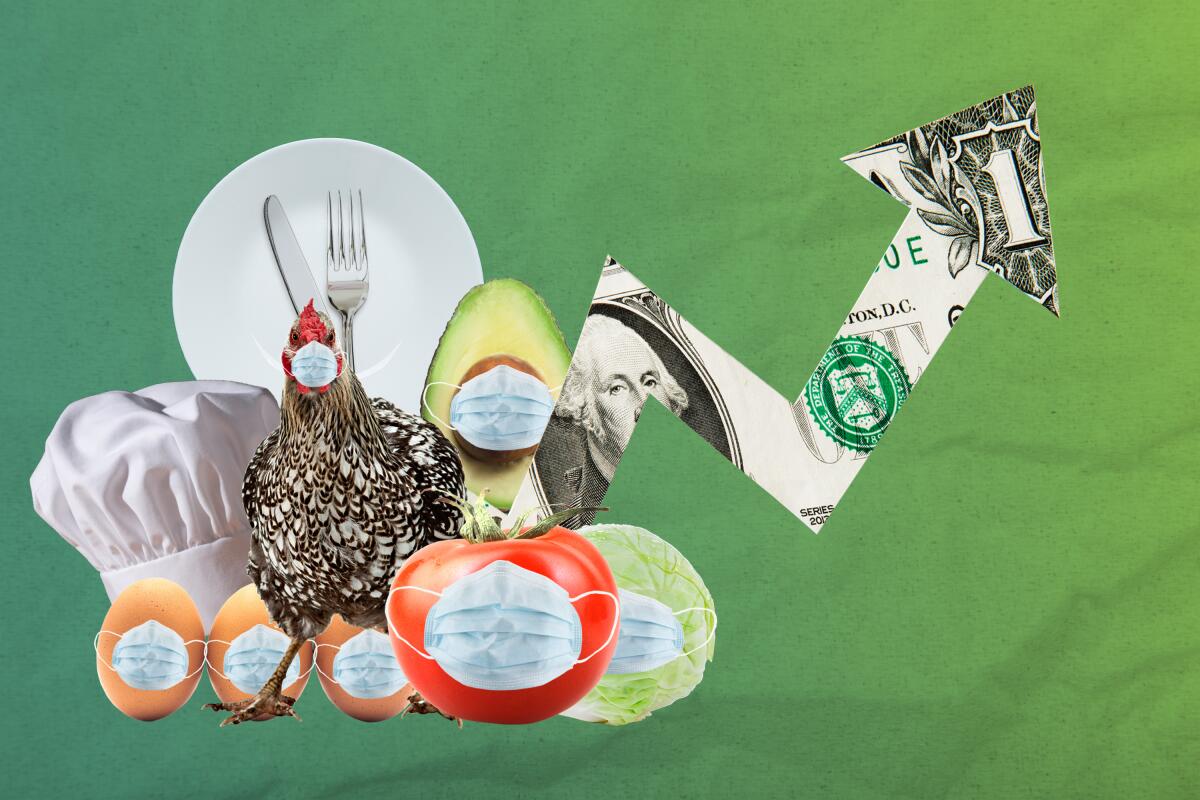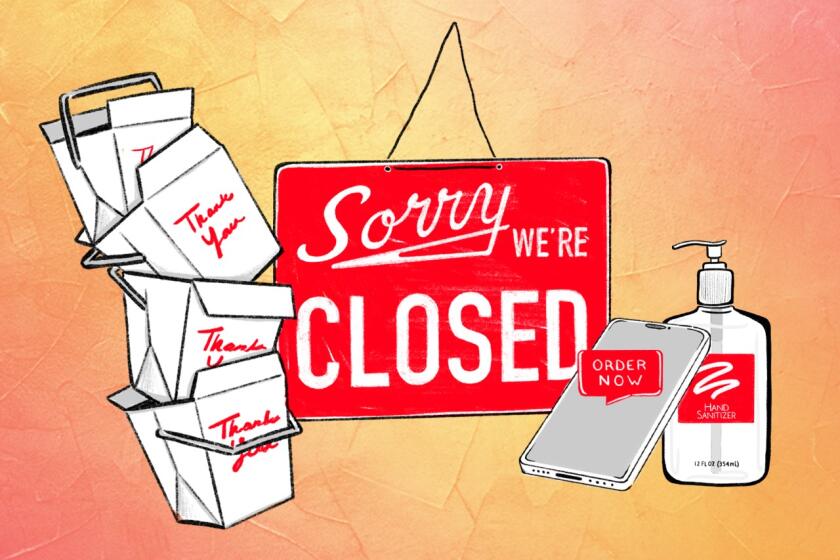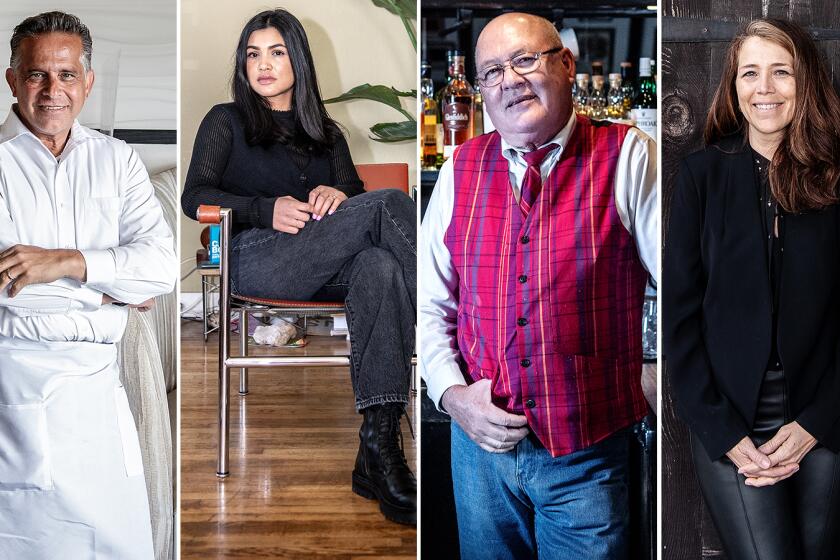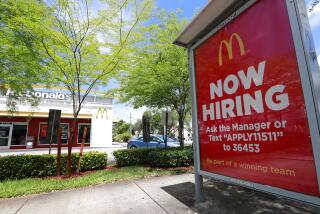Column: We should pay more to eat in restaurants

- Share via
“We’ve raised our prices maybe $1.25 in 10 years,” said Armando De La Torre Jr., owner of Guisados, which opened in Boyle Heights in 2010. “Every time we do it, we are so afraid.
“Whenever we raise our prices, we’re going to lose customers,” he said, adding that Guisados last raised its prices in February 2020. But over the last few years, and particularly since COVID-19 gutted the restaurant industry, “So much has changed in terms of rent, labor, insurance, general liability, and on and on and on,” he said.
“We’re not doing this to be selfish.”
America loves inexpensive food. Cheap-eats lists grace almost all major food websites, and in this democracy the right to dollar menus, 99-cent cans of Arizona Iced Tea and $1.50 Costco hot dogs (drink included!) is nearly as self-evident as the pursuit of happiness.
I’m not criticizing people’s enjoyment of fast food or a cheap snack — I’ve written plenty about that and even hosted a web series dedicated to it. But as we shake off a year of pandemic brain fog and barrel toward a return to indoor dining, independent restaurants continue to face challenges. Rising food and labor costs, pandemic-related expenses (additional training, PPE, outdoor dining tents and propane heaters), high delivery-app fees, and new competition from ghost kitchens and low-overhead pop-ups make climbing out of the COVID hole that much more difficult.
Eating in restaurants should be more expensive. It’s worth it.
This won’t be a popular opinion; raising restaurant prices would put dining out, already a luxury, out of reach for some. But as a country, we’ve become so used to the idea of cheap food, we’ve forgotten the actual cost of hospitality: the time and labor that goes into growing, preparing and serving a responsibly sourced meal.
No one wants to pay more to eat out. But while rising costs shouldn’t be borne exclusively by diners, the burden can’t rest solely on our restaurants either. In an age when it’s common to shell out thousands on personal electronics without a thought, does it make sense to chafe at a salad costing more than $12?
The World Health Organization announced the coronavirus outbreak had become a pandemic on March 11, 2020. Since then, the virus has seemingly touched all aspects of life in Southern California and beyond. The Times looks back on a full year of life in a pandemic.
The growing dominance of fast food in the restaurant landscape also has fueled the notion that some foods — tacos, pho, sandwiches — “should” cost only a certain amount. And if we balk at a price perceived as too high, there’s inevitably a Panera down the street that’s more than happy to satisfy our sense of “should.”
“The economics of our situation are less favorable than ever,” said Heather Sperling, co-owner of Botanica, the Silver Lake restaurant. “And they were never that favorable.”
The highest profit margin Botanica has been able to achieve since opening in May 2017 is 5%. In 2019 it was 3%. “This is just an unbelievably expensive industry,” said Sperling. She and co-owner Emily Fiffer “could and might have to” raise prices in the near future. “We get very nervous about that,” Sperling said.
Botanica has relatively high food costs — around 30% of the restaurant’s expenses — largely due to its ethos of sourcing from small, local producers. And with every dish comes the calculus of assigning a price that not only allows the restaurant to make a small profit but incorporates what Sperling calls “emotional” or “contextual” cost.
“How are they going to perceive the value of this dish?” Sperling asked. If diners decide they could cook a given dish themselves at home, the sense of value decreases. One Google reviewer wrote of Botanica’s Turkish eggs, “So if your [sic] the ultimate hipster who likes to pay $16 for 2 eggs and some lettuce then this is the place for you!!!”
Sperling responded by explaining the local sourcing of the eggs, lettuce and bread in the dish, and why that necessitated the price tag.
“It’s a very challenging line to walk,” she said.
De La Torre constantly wrestles with perception and expectation at Guisados, with seven locations, which he operates with his father. They face an additional barrier — a preconception some hold that Mexican food should be inherently cheap.
“It’s a really difficult situation to be in,” De La Torre said, “especially for our specific situation: We sell tacos.”
Part of Guisados’ mission is educating consumers that there’s more to Mexican food than carne asada, he said, as well as disabusing diners of the notion that tacos should always be cheap. “A taco costs more than a dollar to make, and we need more to survive than a dollar per taco,” he said.
That bias — the notion about how some things “should” be priced — makes it even harder to fight rising food costs. The Producer Price Index (prices that domestic producers receive) increased 12.4% for farm goods between February 2020 and February 2021, according to the Bureau of Labor Statistics. (By comparison, there was only a 3.9% increase for processed foods.)
One week, as an experiment, De La Torre charged 25 cents for salsa to help defray the cost. The feedback was immediate and overwhelmingly negative. “We had to stop it right away,” he said.
“I get customers that bring their own avocados. They bring their own avocados,” De La Torre said. “I don’t think they’re bringing their own pita bread into Bavel!”
A look back at how the pandemic reshaped L.A.’s restaurant scene
Guisados’ prices still receive criticism and comparisons with cheaper competitors. But with the rising cost of labor in California ($14-an-hour minimum wage for businesses with more than 25 employees), there was no choice. “If Guisados was still operating at $2.50 per taco, which is where we started at, we would have been closed by now,” De La Torre said.
Food cost is only a portion of what restaurant owners wrestle with. The other big part — a thornier part — is the cost of labor. The traditionally accepted disparity in pay between front- and back-of-house employees is rooted in racial and class bias: A 2015 study conducted by the nonprofit Restaurant Opportunities Centers illustrated how Black and Latino workers were less likely to be employed in more lucrative front-of-house positions — hosts, servers and bartenders — than their white counterparts. Some restaurateurs are working to change that disparity, but raising back-of-house wages necessitates the further shaving down of thin profit margins or exploring other avenues to get that money.
Within front-of-house remuneration lies another issue: that of tipping, another traditionally accepted practice that has been shown time and time again to be regressive and problematic.
But it’s also a practice that’s difficult to end. In 2015, restaurateur Danny Meyer decided to raise menu prices and adopt an all-in, no-tipping policy in the name of pay equity. But he soon encountered a difficult truth: It’s hard to get rid of tipping unless everyone else gets rid of it too. Line cooks got raises but some servers took pay cuts — and promptly quit. Meyer’s hospitality group officially ended the policy last year. Other restaurateurs, including David Chang and Tom Colicchio, also briefly experimented with a no-tipping model but ultimately reverted.
At Botanica, Sperling weighed options to cover rising costs, including adding an 18% to 20% service charge to checks, a practice more restaurants are beginning to adopt. She eventually settled on adding a smaller 4% service charge in 2019. That extra cash allowed her to guarantee back-of-house staff an additional $2 per hour while avoiding the potential tax burden of collecting 18% to 20% from diners — money considered revenue for the restaurant.
The psyche of the diner is another consideration. Adopting a policy of eliminating tipping but substantially increasing menu prices was not an option for Sperling: “People see [higher menu prices] and they get total sticker shock,” she said. While a $19 entree might end up costing $25 with tax and 20% tip, diners still want to see that smaller number on the menu.
At Guisados, De La Torre has opted for small price increases instead of an additional service charge. Even if he were to clearly spell out that the money went entirely to restaurant workers, he said, “A lot of customers wouldn’t want to pay that,” firm in their belief that “restaurants are responsible for paying their employees.”
In 2014, Zach Pollack, chef-owner of Alimento and Cosa Buona, began adding a separate tip line for kitchen staff on checks at Alimento in 2014 — something he got “a ton of heat” for. He derided the notion that 20% of a restaurant’s income should be exclusively reserved for servers: “The idea that a fifth of the money that consumers spend on an industry whose margins are 10% on a good day goes exclusively to waitstaff was insane to me,” he said via Instagram direct message. (In 2018, Congress vacated a law that prohibited tip-pooling with back-of-house employees.)
Small farmers, meanwhile, are fighting their own battles with pricing. Meredith Bell, owner of Autonomy Farms in Bakersfield, specializes in hormone- and antibiotic-free meat and eggs. She said customers at L.A. farmers markets are understanding of her prices, which are higher than you’d find at large supermarkets. Still, the margins aren’t enough for her to provide health insurance for her seven employees, something she aspires to do.
Bell competes with large-scale meat producers that operate less sustainably than she does but can sell meat for a fraction of the price. Bell sells chicken retail for $6.50 per pound. At big chain stores, it’s easy to find chicken for $1 per pound; Costco famously sells a $4.99 rotisserie chicken.
“I don’t know what they do,” Bell said of large purveyors. “I don’t know how it’s financially feasible.”
A longtime bartender, server and two managers look back at a year of COVID-19
Economies of scale explain some, but not all, of rock-bottom meat prices. “It blows my mind when people offer turkey at 99 cents a pound,” she said. “My cost of just getting the turkey at 2 days old is $7.” Then, there’s the cost of raising the animal for the next five months.
“It’s almost misinformation,” she said. “When people are buying cheap food, no one stops to think: How do they do this? What am I eating here?”
Bell rejects the notion that eating healthy, sustainable food is a luxury for the rich: “It should not be for elitists,” she said. “Good food should be accessible to everyone.” But she has to pay much more to process chicken — around $3.75 per bird — than large-scale producers, who can pay a fraction of that amount. “I have to be given the same opportunities to get my animals processed and slaughtered,” she said.
Ultimately, she’s concerned about farmers being pushed toward greater efficiency at the cost of quality. “I worry about the future of food and where it’s going,” she said.
How did we get here? And what are some possible solutions?
Krishnendu Ray, associate professor of Food Studies at New York University, will tell you that America’s cheap food obsession began in earnest during the Reagan years. “From the 1980s on,” he said, “It becomes a patriotic American thing to be suspicious of government [and embrace] lower taxes. And cheap food became a part of the package.”
In addition, a long history of immigrant butchers, bakers and restaurateurs, Ray said, adopted a labor model where owners employed family members, often unpaid. When that’s the tradition, it becomes difficult to “carry the burden of a worker making a livable wage,” Ray said. That industry model still weighs on some restaurants today, which run on paper-thin margins and have few corners left to cut.
“The consumer has to pay some of the price,” Ray said, “if we care about better food, better jobs, better care of animals.” But the government, he said, also must pitch in. Medicare for all or an extension of the Affordable Care Act would be a way of “socializing the cost” of supporting restaurants by ensuring the health of workers.
Ray also suggested that the restaurant industry unite to address the growing dominance of delivery apps, which charge fees he calls “criminal.” He pointed to developments in Singapore during the pandemic as an example of what could happen when “instead of competing to the bottom, you collaborate with each other.”
Entrepreneur Jack Ong worked with a group of developers to create Makan Guru, a delivery app created to help Singapore’s beloved food-hawker community. The app takes only a 5% commission (30% is standard) and proceeds are donated to a local YMCA. Less formally, a Facebook group called Hawkers United acts as a hub for people to promote their favorite vendors, sharing addresses and phone numbers to encourage diners to buy directly without a middleman. The group has 286,000 members — not bad for a country of 5.7 million.
That kind of noncompetitive banding together is what ultimately will give restaurants a fighting chance in this new era. Could it happen in a country as vast and individualistic as the U.S.? “American politics is changing,” Ray said. “That’s what’s hopeful. At least half of Americans are willing to consider these things.”
If we care about sustainable food, more equitable pay for workers and supporting an industry as it recovers from its annus horribilis, we’ll need to. And it will be worth it. “I’ve been saying for years the best deal to be found anywhere is just eating at a restaurant,” Pollack said.
He’s right. Good food, and good service, are worth paying for.
More to Read
Eat your way across L.A.
Get our weekly Tasting Notes newsletter for reviews, news and more.
You may occasionally receive promotional content from the Los Angeles Times.












